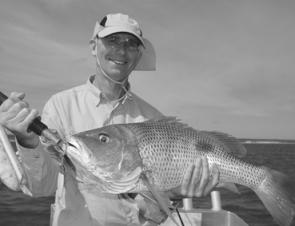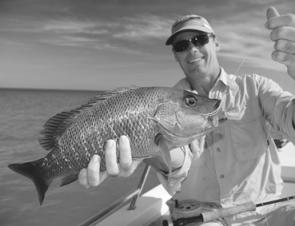While anglers living south of the Tropic of Capricorn often wake up to mornings that make them want to pull that doona a little closer, most up in TNQ can’t wait to kit up in shorts and tee, grab a rod or three and immerse their bare feet in the lukewarm winter water.
The locals start whinging if the mercury plunges below 18, get very annoyed if raindrops speckle the dust on their windscreens and the crocs spend a lot of time soaking up the sun.
As far as that other famous northerner, the barramundi, is concerned, August is when these fish can be hardest to find. Water temperatures are about as low as they go up this way so the ‘Mundi family’ are generally more intent on lying in the shallows soaking up a bit of sun than chasing a feed of baitfish.
The only time they show a bit of interest is when there is a low tide around the hottest time of the day. The flats heat up in the sun and when the water starts flooding the edges, it quickly warms into fish friendly streams.
A couple of extra degrees is all that is needed to turn barra into the scourge of the mullet hugging those edges. It’s a bit like coming out of a frosty night into a cosy restaurant – you immediately feel hungry.
But these tidal events are the exception rather than the rule. For the majority of the time, catching barramundi can be a very difficult task indeed!
The cooler water also has the same effect on mangrove jacks and threadfin salmon – they are there but are sometimes reluctant to bite. Trying the deeper holes is therefore the obvious way to go, with species like fingermark, estuary cod, grunter and trevally the target.
Along the beaches, the water is generally clear and the baitfish plentiful. Queenfish, giant herring and golden trevally will be on the prowl, particularly on the first half of the run-out tide, but the cooler water can make the fish shy.
The one species that does become quite active here in winter is the pikey bream. It’s a species often overlooked when the focus is on its larger and more high profile swimming mates but there are plenty of pikeys around that would win bream of the month contests in the southern population centres.
Schools of big bream often congregate around the river and creek mouths in late winter in preparation for spawning. In the right mood, they will take a fly, small lure or fresh bait.
The shallow reefs along the Gulf coast are easily spotted once the water clears and can provide lots of fun when drifted while casting hard-bodied or soft plastic lures, or by trolling with lures that keep close to the bottom. Being destroyed by a thumping estuary cod or trophy sized fingermark is always on the cards when working these areas.
Further offshore, the longtails should still be working the bait schools along with a few cobia, queenfish and trevally but the big mover at this time of year is the narrow barred Spanish mackerel. The macks start to school in winter and can turn up in big numbers.
The size of the Spaniards averages from 7-12kg but there are always a few larger ones hanging around. Trolling big Halco Scorpion Crazy Deeps works well with our favourite colours being red stripe, Qantas (red head, white body), chrome silver multi and deep purple.
If the fish are showing on the sounder but not hitting the trolled lures, then dropping metal jigs to the bottom and working them back to the surface quickly can get them interested. Our favourite jigs are Lazers, Raiders and Snipers in 70-90g rigged with a short length of 40kg breaking strain single strand stainless wire.
Sharks often follow the mackerel schools and can make landing a hooked fish just about impossible, as well as racking up some expensive tallies of lost lures. If the Noahs get nasty, moving on is the sensible thing to do, as the next hotspot might be more accommodating.
One minor disadvantage of our warm winter weather is that any fish kept for eating should always be placed on ice as soon as possible after being killed and bled. Many southern visitors neglect to carry sufficient ice and can spoil their fish as a consequence.
The fishing in August might be a bit slow to those of us who live here all year round but it is still a whole lot better than what is available down south, at least that is what I am regularly reminded of by satisfied clients!
Leaders are an integral part of rigging for tropical species like barra and threadfin salmon and I’ve witnessed numerous instances of fish being lost due to the lack of, or insufficient strength in, a leader. I sometimes get very annoyed about the information on leader strength portrayed by visiting southern ‘experts’ who have obviously been lucky during their short sojourns to our tropical waters and recommend leader line strengths that aren’t conducive to the sandpaper jaws of even a medium sized threadfin or barramundi.
While it’s probably not politically correct to begin a product review by getting on my soapbox, I do feel for anglers who think that they have read the best available information only to find that the largest barra of their long awaited northern expedition has swum away with a lure in its mouth after their carefully tied leader has worn through. It’s doubly worse when it’s a client who has decided to ignore my advice and stuck with the local southern-based guru’s so-called good oil.
You can bet that he’ll replace it with my leader immediately after, while grinning sheepishly, but then it just might be too late! The best lessons are often learned the hard way, particularly in fishing.
Getting back to leader material, like guides and fishing gurus, they are definitely not all the same! If you are using braid, these differences can be worse, and to make the problems even more complex, some braids are more resistant to tying effective leader knots than others.
I know I’ve opened a can of worms here so let’s get some sort of criteria established. Beware of leader material that is ‘slippery’ and braids that have the smoother coatings.
Tying effective leader knots, in particular the popular braid to leader or ducknose knot, can be almost impossible if the two types above are combined! If in doubt, a drop of Super Glue on the finished knot may help but pulling the knot as tight as possible is always the best way to go.
I’m happy to say that the Sure Catch Hi-Tensile saltwater leader material that I’ve tested extensively ties an excellent knot and is definitely not one of the slippery ones. Being fluorocarbon, it is a fair bit stiffer than normal nylon leader material but this does not seem to hinder its knot strength or integrity.
It’s been used extensively from lure casting to barra and jacks, poppering for queenies and GT’s, jigging the reefs and bait schools and as shock leader for fly tippets. Both the braid to leader knots and loops used with lures and flies tie easily and firmly.
For estuarine fishing, I recommend at least a 40lb (20kg) leader strength or 60lb if larger fish are expected to be encountered. Because of the improved abrasion resistance of the Sure Catch fluorocarbon, the 40lb strength does an excellent job in most estuarine situations, but as always, check the working end of the leader after every fish is landed and remove any abraded sections.
The 60lb (27.3kg) Hi-Tensile leader has proved very effective in the offshore arena but like any non-wire material, doesn’t like the direct attention of the razor gang. Its thinner diameter compared with normal nylon monofilament seems to allow jigs and soft plastics to have a better action, particularly when wire isn’t used.
I used some of the 40lb Hi-Tensile when dropping soft plastics to a potential black jewfish ground in 15m of water and successfully pulled a 12kg model out of some pretty tricky country with minimal damage to the leader. That’s the sort of test that gives you confidence in the tackle you are using – and, more often than not, the leader is the weakest link.
Tackle evaluation in Weipa will soon sort out any inherent weaknesses in product as we’ve often found to our dismay. The Sure Catch Hi-Tensile leader is still being used so it’s obviously passed the test.
Reads: 2074
This big fingermark ate an assist hook rigged metal jig on one of Weipa’s offshore reef areas.

Big jacks like this beauty taken by Peter on a fly can be found on the rocky headlands in the cooler months in the Gulf.

The Sure Catch Hi-Tensile leader is a great product for those thinking of coming north.




